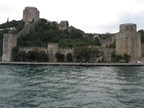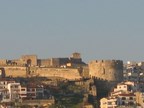In Byzantium, the castle had purely military character and its mission was to protect the empire from the Barbarians. The most of the Byzantine cities were walled entirely. The frightening aspect of the walls, the difficulty of manufacture, the labyrinthine mazes, the conflicts and the violence caused legends which are alive until the recent days. The castles were built at defensible locations to control nearby roads and provide security for their inhabitants and those of the surrounding area in times of war. They provided the basic functions of an urban center but their confinement and often uneven terrain affected urban planning and domestic architecture.
The most of the byzantine cities were completely walled and the most remarkable example is the byzantine capital, Constantinople (known in modern times as Istanbul). In the castles which were built for protection, there were the homes of the guards and the generals, the water tanks and the warehouses. The towers which were at the corners of the walls and equidistant from each other. This is where the catapults and the ballistic machines were placed. Outside the wall there was a moat constructed . The entrance into the castle was carried out through a sliding bridge which behind it there were hidden moving doors. The ancient people believed that the forts were built by people with supernatural abilities who had the power to move these huge stones. The master builders were killed after the completion of the construction in order not to reveal the secrets of the castle and especially not to speak about the secret places where the treasures were hidden. The labyrinthine tunnels of the each castle complete the mystery of a world that knew well how to keep its secrets. These tunnels included systems for ventilation and lighting and were used to hide the civilians during battles. The tunnel covered a long distance of many kilometers, worked as an emergency exits and were contacted with the others towers. In the castles there were prisons as well. The handcuffs of the prisoners were heavily wedged in the wet huge stones. The prison conditions were inhuman and escape was simply impossible. The castles as prisons experienced political prisoners, criminal outlaws, ideological dissidents or imprisoned patients as the lepers of the castle of Spinalonga.
Some of the castle features
The gates: The gatehouses were inside the wall and connected with the bridge over the moat, but they were more than just doorways. The gates were usually long tunnels with arrow looped towers at the both sides of the entrance. The outer opening of the gatehouse tunnel was covered by a grated wooden or iron gate. In the ceiling of the gatehouse tunnel, there were openings called murder holes through which defenders could drop objects and hot liquids. Finally, the gatehouse had a heavy wooden door at the inner opening, which soldiers could shut and lock with braces. The bridge’s retraction mechanism was usually located inside the gatehouse. Some drawbridges were raised and lowered with a winch and some had a center fulcrum that allowed them to pivot perpendicularly to form a wall. Some bridges had an additional fortified structure in front or alongside them called a ‘’barbican’’. The barbican was built of stone and had towers with arrow loops and battlements.
The bastion: The bastion had usually an autonomic fortification but also was part of a bigger fortress. The bastion could be totally cut from the rest castle. The most famous bastions of Greece are these at the fortress of Palamidi.
The moat: The moats were artificial trenches in the ground with quite large depth and width and were located around the external walls of the castle to strengthen its protection. The moat could be empty or full of water. Legends say that in the moats were kept monsters or huge crocodiles to scare the possible invaders. The most characteristic moat of the Greek castles is the moat at the fortress of Methoni. It was usually full by sea water but today it’s empty (obviously for the protection of the monument by the erosion).
The bailey: A bailey was a fortified enclosure. It was a common feature of castles and the most of them had at least one. From a military standpoint, this courtyard was a wide open space. So any invading soldiers who made it through the gate into the bailey would be exposed to arrow fire from the outer walls and towers and the inner walls and towers. The bailey also served as a marketplace for festivals and fairs, a practice field for drilling soldiers and training horses and an area for tournaments.
The battlement: Battlements were most often found surmounting curtain walls and the tops of gatehouses and comprised several elements: crenellations (crenellation is the collective name for alternating crenels and merlons), hoardings, machicolations, and loopholes, gaps and solid blocks on top of a wall. Hoardings were wooden constructs that projected beyond the wall, allowing defenders to shoot at, or drop objects on attackers at the base of the wall without having to lean perilously over the crenellations, thereby exposing themselves. Machicolations were stone projections on top of a wall with openings that allowed objects to be dropped on an enemy at the base of the wall in a similar fashion to hoardings.
Arrow slits (usually known as loopholes) were narrow vertical openings in the defensive walls which allowed arrows or crossbow bolts to be fired on attackers. The narrow slits were intended to protect the defender by providing a very small target but the size of the opening could also impede the defender if it was too small. A smaller horizontal opening could be added to give an archer a better view for aiming.
In conclusion
Greece is full of castles and towers. They are a very important part of the Greek history and cultural heritage. Although the Byzantium is historically somewhat ‘’undervalued’’, survived for a long time thanks to its castles and the heavy walls against the invasions of the Barbarians who wanted its riches. So it’s a very interesting and special attraction to visit when you travel around this beautiful country, Greece.




